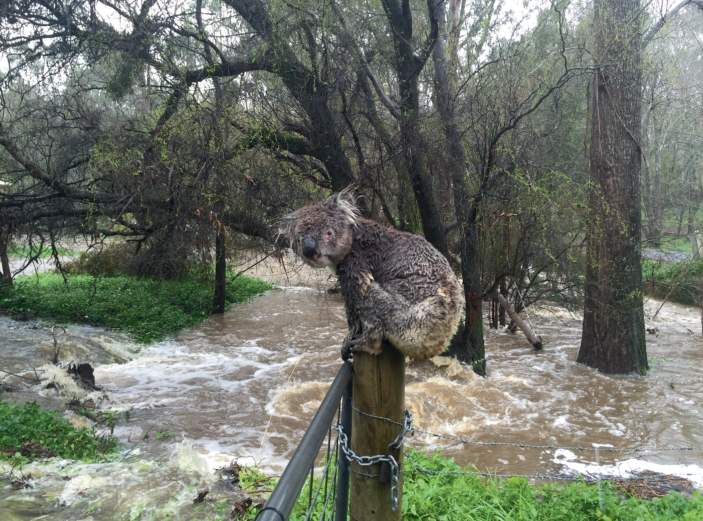BY Tim S. Doherty &
Kristina J. Macdonald, Nature Ecology & Evolution
A meta-analysis demonstrates that non-native species are often more resilient to extreme weather events than their native counterparts.
From droughts and floods to heatwaves, cold spells and storms, extreme weather events (EWEs) cause abrupt changes in ecological energy flows and resource availability and have marked effects on ecosystems and their constituent animals. Although EWEs are a normal part of Earth’s dynamic biosphere, their frequency and intensity are increasing across the globe owing to anthropogenic climate change. There is intense community and scientific interest in the effects of EWEs on animal populations. Much work has been done to document and understand these effects, but there has been relatively little focus on integrating these findings across a diversity of species and ecosystems, especially in a quantitative manner. Writing in Nature Ecology & Evolution, Gu et al. assessed the relative effects of EWEs on more than 2,000 native and non-native animal species from terrestrial, marine and freshwater environments worldwide.

A koala among floodwaters in South Australia in 2016.
The authors tackled this issue from several directions, including a statistical comparison of EWE exposure between native and non-native species; a meta-analysis of experimental and observational studies; and a spatial analysis of overlap between potential species invasion and EWE hotspots. The meta-analysis involved more than 4,000 effect sizes for native species and nearly 1,000 for non-native species. The breadth of the data is impressive: they cover species representing 17 taxonomic classes and 134 orders, ranging from tiny caddisflies to comparatively gigantic reindeer.
Overall, Gu et al. found that native species were more likely to respond negatively to EWEs than were non-native species. Across the 24 combinations of EWE and ecosystem type, native species showed an overall negative response in seven cases and zero positive responses whereas non-native species showed two negative and four positive responses (the remainder were neutral). Cold spells and droughts in terrestrial systems had the strongest negative effects on native species, whereas non-native species showed an overall positive response to cold spells and a neutral response to droughts in terrestrial environments. Although this study did not test for traits that may make non-native species more resistant and resilient to EWEs, past work indicates several possible mechanisms: these include rapid growth rates, short longevities, high reproductive rates and higher behavioural plasticity — all of which are traits that assist non-native species in establishing in the first place8.
Given that non-native species themselves are a key driver of ecosystem change and biodiversity loss, there is strong potential for synergies to occur between invasive species and EWEs. For instance, EWEs can transport non-native species into new regions, make environmental conditions more favourable for their establishment and place native species at a competitive disadvantage. Gu et al. identified potential hotspots for the combined impacts of non-native species and EWEs by overlaying modelled distributions of non-native species with maps of EWE occurrence and intensity. This approach revealed southern Australia as a potential hotspot for the combined impacts of heatwaves and invasive species, and central and northern Europe as a hotspot for storms and invasive species. A large number of small hotspots for droughts and invasive species were identified throughout South America, Europe and south-east Asia.
One limitation of this approach is that it uses current and historical data, whereas future climates are expected to make some areas either more or less suitable for invasive species. For instance, future range modelling for six invasive vertebrates on the Iberian Peninsula generally revealed net losses of favourable habitat in 2021–2050, although there were local areas where new invasions may occur. At the global level, climate change is predicted to reduce the ranges of several bird and amphibian species, whereas terrestrial and aquatic invertebrates are predicted to experience range expansions in most cases. In addition, the location, frequency and intensity of EWEs are predicted to change as global temperatures continue to rise and weather conditions change. Gu et al. used the effect sizes from their meta-analysis to account for the fact that non-native species responded both positively and negatively to EWEs, and we suggest that incorporating this information into climate projections would be a fruitful avenue for future research.
Understanding the underlying mechanisms that shape how different species respond to EWEs is a crucial area for further research. Species’ traits and environmental factors can help to predict organismal responses to EWEs, but there has been limited focus on the differences and commonalities between native and non-native species. Further analyses could help to answer questions such as whether native and non-native species with shared traits demonstrate similar responses to EWEs, or whether species with greater evolutionary exposure to EWEs are more resilient to such events. Answering such questions could help to increase the predictive capacity of ecosystem models and assist in the design and prioritization of conservation actions. Understanding and mitigating the ecological effects of EWEs and non-native species is critical during this era of rapid global change.
No comments:
Post a Comment